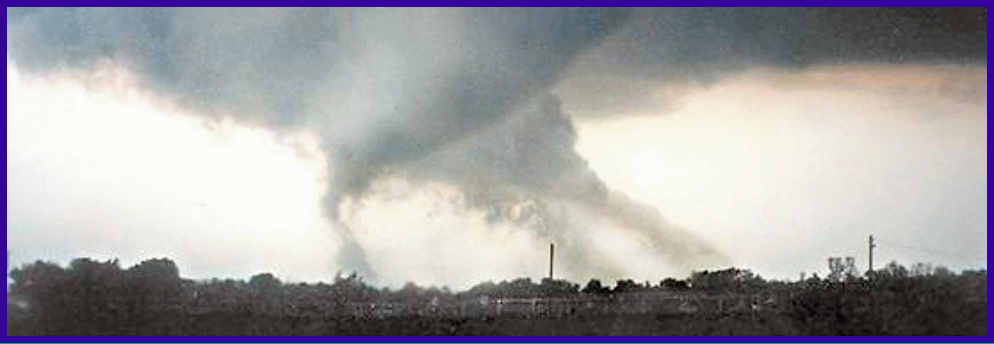by David Sills, Meteorological Service of Canada

The 17 July 2000 tornado in Guelph moving from NW to
SE. Photograph by Lesley Ord, facing east.
by David Sills, Meteorological Service of Canada

The 17 July 2000 tornado in Guelph moving from NW to
SE. Photograph by Lesley Ord, facing east.
The following information is intended to provide assistance with tornado
verification and classification in Ontario. The information is based on
the latest scientific understanding of tornadoes and will be updated as
required. Italicized terms appearing in this document are defined in the
appendix at the end of the document (only the first instance of the term
is italicized).
Tornado Verification
The occurrence of tornadoes may be verified through the availability of several types of evidence including damage surveys, videos, photographs, and first-hand accounts. Each of these will be discussed briefly below starting with the most reliable data and ending with the least.
The best way to verify the occurrence of a tornado is to conduct a damage survey. Damage surveys allow important characteristics of tornadoes to be determined such as path location, path length, direction of movement, path width, damage intensity rated on the Fujita scale (Fujita, 1981), etc. Damage surveys also typically turn up photographic or video evidence of the event or eyewitness descriptions of the phenomena.
Photographic or video evidence of a tornado can be used to verify occurrences but basic characteristics such as path location and path length cannot be accurately determined. Care must be taken to ensure the authenticity of this type of evidence since many images of tornadoes are now freely available and also since modern graphics software is capable of producing very realistic fakes.
Photographic or video evidence of tornadic wind damage can help with the verification of an event but should not alone be considered sufficient for verification since it is very difficult to properly assess damage patterns and intensities through photographs alone. Again, care should be taken to ensure the authenticity of the evidence.
Eyewitness reports of a tornado can be used to assist with tornado verification. Eyewitness reports from experienced and/or well-trained observers such as CANWARN spotters should be considered on par with photographic or video evidence. Eyewitness reports from people with little or no training should not alone be considered sufficient for verification.
Eyewitness reports of a funnel cloud can be used to assist with tornado verification. Eyewitness reports of funnel clouds should not alone be considered sufficient for verification.
Reports of tornadic wind damage, either from newspapers or through first-hand
accounts, can help with the verification of an event but should not alone
be considered sufficient for verification.
Tornado Classification
Mike Newark of MSC started a Canadian tornado database using his own
tornado classification scheme and was able to produce a Canadian tornado
climatology based on this data (Newark, 1984). He used a probabilistic
method for classification including categories for confirmed, probable
and possible tornadoes. Much has been learned about tornadoes since the
time of his work. Thus, a revised classification scheme has been adopted
that brings the criteria up-to-date scientifically and makes them more
objective. The probabilistic methodology was retained to maintain consistency
with Newark's database. For ease of use, the criteria have been implemented
in a decision-tree format, as shown below. Starting with the most reliable
data available for an event, one is able to quickly classify the event
as a confirmed tornado, a probable tornado, a possible tornado, a funnel
cloud, or non-tornadic winds. Note that where combinations of
reports are used (e.g. video of funnel cloud plus report of tornadic wind
damage at the surface), the timing and location for the two reports must
be similar (as a general rule, within 30 minutes and 30 kilometres).
Acknowledgements
This work is part of a larger project being conducted by David Sills
and Patrick King of MSC to improve the quality of the Ontario tornado database.
Thanks go to the following people for their help with this work: Mike Leduc,
Phil Chadwick, Brian Murphy, Pat McCarthy, Tom Grazulis, Chuck Doswell
and Harold Brooks.
References
Doswell, C.A. III, 2001: "What is a tornado?", online essay
Newark, M.J., 1984: Canadian Tornadoes, 1950-1979. Atmos.-Ocean.22:343-353.
Bunting, W.F. and B.E. Smith, 1993: A guide for conducting damage surveys. NOAA Tech. Memo. NWS SR-146.
Fujita, T.T., 1981: Tornadoes and Downbursts in the Context of Generalized
Planetary Scales. J. Atmos. Sci. 38: 1511-1534.
Appendix - Definitions
Terms appear below in the order of their appearance in the above text.
Tornado
There is no widely-accepted peer-reviewed definition of a tornado. However, the following definition suggested by Chuck Doswell (Doswell, 2001) will be used since it embodies the current scientific understanding of tornadoes.
"A vortex extending upward from the surface at least as far as cloud base (with that cloud based associated with deep moist convection), that is intense enough at the surface to do damage at one or more points along its path, should be considered a tornado."
Note that this definition:
Damage Survey
A thorough investigation of the damage caused by winds associated with
severe local storms. etc.....
Tornadic Wind Damage
Tornadic wind damage has the following characteristics:
Funnel Cloud
A rotating condensation cloud that is produced by the decrease in pressure associated with a vortex. It may or may not extend the entire distance between the base of a moist, convective cloud and the surface.
A photograph, video or eyewitness description of a funnel cloud should
indicate a rotating condensation cloud, typically extending from the base
of a moist, convective cloud toward the surface.
Non-tornadic winds
Non-tornadic, damaging winds are frequently associated with downbursts i.e. macrobursts and microbursts (see Fujita, 1981). The winds may in fact have some degree of curvature and/or divergence but are considered 'straight' relative to the rotating winds associated with a vortex such as a tornado. Straight-line wind damage has the following characteristics: